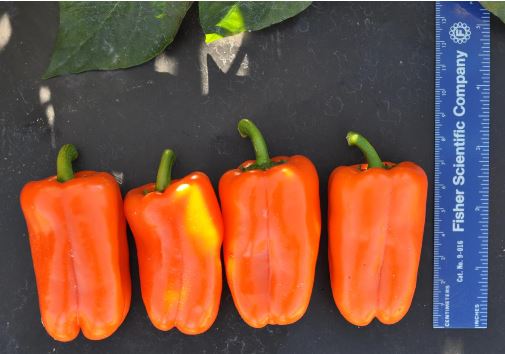USA
June 14, 2019
 Small size of snack peppers.- Credit: John Stommel
Small size of snack peppers.- Credit: John Stommel
John Stommel of the Agricultural Research Service of the US Department of Agriculture (USDA-ARS) has investigated the desirability for, and practicality of, producing snack peppers, both sweet and hot, with low seed count.
His findings are in the article, "Reduced Seed Count Improves Versatility and Propagation of Small-fruited Peppers (Capsicum annuum L.) for Specialty Markets," published in HortScience.
Small/miniature sweet and hot peppers, such as snack peppers, are a rapidly growing class of specialty peppers. As with grapes and watermelons and certain other fruits, low seed count is an important attribute for consumer acceptance of small-fruited specialty peppers. But, this attribute is understandably counterproductive in terms of maintaining a strong continuous yield.
Environmental stress conditions, including high or low temperature, humidity, high or low light intensity, heavy rain or drought, and even strong wind, negatively affect the quality of fruit and growth. These conditions can also induce fruit to be seedless or with significantly reduced seed.
This is known as parthenocarpy, the development of a fruit without prior fertilization. In parthenocarpy, the ovary is stimulated even without pollination and thus fruit development begins without fertilization. Some of this occurs naturally, as with bananas, pineapples, and persimmons, to name but a few. Other examples are a result of thoughtful intervention.
Induction of parthenocarpy is a common agricultural practice for some horticultural crops. Selective breeding for parthenocarpy has demonstrated the utility of seedlessness for improved yield and quality in selected environments.
Small sweet peppers are popular among consumers because of their versatility, snackability, vibrant colors, and nutrition attributes. Mature peppers comprise the majority of the snack pepper market segment due to enhanced sweetness and the aroma of ripe fruit.
Although characteristically pungent, no-heat habanero cultivars within the snack market class provide unique fruity and floral attributes of the habanero without fruit pungency.
Seasonal field production is supplemented by year-round greenhouse production. Although field production of traditional pepper commodities is in decline in parts of the country, other segments, including snack peppers, are expanding greenhouse acreage for high-value pepper production.
A relatively small number of commercial snack pepper cultivars have been developed, many of which lack uniformity and quality attributes such as low seed count, which enhances culinary convenience for product end users.
True breeding pepper lines selected for reduced fruit seed count exhibited significantly reduced seed count relative to breeding lines with seed set typical for pepper.
The complete article is available in the ASHS HortScience journal: https://journals.ashs.org/hortsci/view/journals/hortsci/54/4/article-p652.xml. DOI: https://doi.org/10.21273/HORTSCI13602-18. Or you may contact John Stommel of the US Department of Agriculture, Agricultural Research Service at john.stommel@ars.usda.gov, or call him at (301) 504-5583.
Founded in 1903, the American Society for Horticulture Science (ASHS) is the largest organization dedicated to advancing all facets of horticulture research, education, and application. More information at ashs.org.